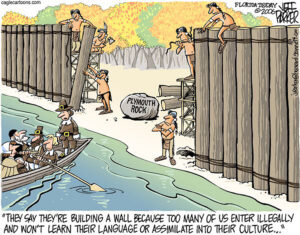MNN. Stop redacting Canada’s past and current genocide policy. Redact is to remove words or information from a text before it is made available to the public. In other words. lying. The latest is Prime Minister Carney’s Bill C5, the “One Canadian Economy Act” of the colony of Canada to take indigenous land and resources without consulting us, the land owners and caregivers. We allowed them to live here by agreeing to follow the teiohateh Two Row and kaianerekowa Great Peace. They reneged on the agreement and so are now in breach of it.
Yes, Canadians and their ancestors were all there and benefitted from the killing of the original people. We survivors know what they did to us. Our blood is in all of turtle island. Regardless of these atrocities, we will sing our songs and tell our stories. We refuse to live our life under their oppression. They murdered us because we are the indigenous protectors of the land they covet. We are positive that we indigenous of onowarekeh turtle island will continue to be partners with creation and to be our mother earth’s caretaker no matter what the colony of Canada plans and schemes. We ask the world to stand with us. Canada and the United States are colonial corporations that fear the truth. We were murdered so they could accumulate riches on our backs, steal our inheritance and give it to their children. They are still here because they are still stealing our resources. They are not citizens of turtle island. They are subjects of the private corporation of Canada. 
Everywhere on turtle island the colonists have sites, cities, towns, municipalities, structures, monuments and roads named after the killers, infiltrators and perpetrators while illegally squatting on our lands. Every part of onowarekeh has been made a tourist attraction to earn money. The attraction is “Come and see the blood we spilt to violently take this paradise from the original people and turn it into a garbage dump.” Every square inch of onowarekeh should have a signpost about the true history of their project to murder us out of existence. Tourists should be told what our responsibilities to this land are. And to stop ordering us to “get over it”. We will never get over their planned atrocities that they keep lying about. Many don’t want to stop lying. Surprisingly, a few of their descendants recognize the true history of the genocide and want to support our initiative.
 The whites basically know the truth about what they did and are still doing. These liars are controlled by the dollar along with their native traitors we refer to as the “hang around the fort Indians”, who are also controlled by the dollar. We traditional Indigenous will sing and share our stories forever. Our true history was never lost. It goes into our DNA as a memory that is stored in our bloodline going back to the beginning of time and into infinity. The DNA of the squatters and their criminal behavoir proves they don’t belong here. The Canadian and American colonists will soon come to terms with that truth. Their prosperity is all based on their spilling our blood, which was their initial goal. We are asking them to educate themselves on the whole unvarnished truth. We remember how the white soldiers surrounded our villages in military uniforms, armed to the teeth and giving us nowhere to run, as recent as 1990 in kanehsatake Oka when we stopped them from chopping down our white pine trees to extend a golf course for white people. There are countless attacks against the real sovereign people. Canada and the US have unfinished business with us. Creation is always aware of the truth of this destruction that they plotted and carried out. We still see the beauty of creation and the genius of those who survived their genocide policy.
The whites basically know the truth about what they did and are still doing. These liars are controlled by the dollar along with their native traitors we refer to as the “hang around the fort Indians”, who are also controlled by the dollar. We traditional Indigenous will sing and share our stories forever. Our true history was never lost. It goes into our DNA as a memory that is stored in our bloodline going back to the beginning of time and into infinity. The DNA of the squatters and their criminal behavoir proves they don’t belong here. The Canadian and American colonists will soon come to terms with that truth. Their prosperity is all based on their spilling our blood, which was their initial goal. We are asking them to educate themselves on the whole unvarnished truth. We remember how the white soldiers surrounded our villages in military uniforms, armed to the teeth and giving us nowhere to run, as recent as 1990 in kanehsatake Oka when we stopped them from chopping down our white pine trees to extend a golf course for white people. There are countless attacks against the real sovereign people. Canada and the US have unfinished business with us. Creation is always aware of the truth of this destruction that they plotted and carried out. We still see the beauty of creation and the genius of those who survived their genocide policy.
They have to start telling their children the truth and that it is time to listen to us. We don’t listen to their pleas of, “It happened so long ago. So forget about it”. To begin the reckoning they have to start by not lying, admit that they committed cruelty and malice against the indigenous people and that they have to stop their policies to continue this. They have incriminated themselves by destroying the records of the death and torture they committed on us. They must stop destroying their documents about all this, about throwing them down wells or burning them or hiding them or redacting them. They fear the consequences of their crimes of the past and present. Though they committed them recently they cannot look us in the eye without shame or guilt like psychotics who feel no guilt or remorse. To set the records straight we suggest they publish and make available to the public all their records as historic documents and not as moral confessions, even though we already know the truth. They can redact the documents all they want, but they can’t redact our minds!
Dedicated to the adversaries of the indigenous people and to a broken dispassionate world is Jelly Roll’s awsome song “Liar”:
mohawmothers.ca
box 991. kahnawake quebec. canada. J0L 1B0


























